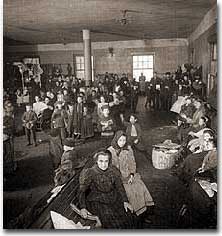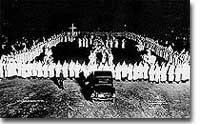47c. Intolerance

As people from other nations began to pour into the United States, some Americans began to resent their presence and blame them for economic and social problems
Sometimes the battle got ugly. Old versus new was not a conscious topic to be discussed calmly at the nation's dinner tables. In an effort to preserve so-called true American values, the forces against change sometimes displayed intolerance ranging from restrictive legislation to outright violence. Immigrants from areas outside Northern and Western Europe became targets of narrow-mindedness. African Americans faced new threats from a resurgent Ku Klux Klan. Socialists, anarchists, and atheists beware! The message was simple and clear. Conform or else.
Restricting Immigration
Since the 1880s, America's shores were flooded with immigrants primarily from Southern and Eastern Europe. The old nativist arguments grew louder in the first two decades of the 20th century. Critics of an open immigration policy cried that America's racial stock was being overrun by undesirable ethnicities. Protestant fundamentalists worried as the numbers of Jewish and Catholic Americans grew larger. Labor leaders claimed that immigration lowered wages. As a result, Congress slowly built walls against the newcomers. The first line of defense was a literacy test, passed in 1917. The results were not as encouraging as the nativists had hoped. About 1.25 million immigrants still entered America in the first two years of the twenties. An outright cap on immigrant numbers was enacted in 1921. Ethnic nationalists claimed that these conditions favored Southern and Eastern immigrants too favorably. The result was the National Origins Act of 1924. This law based admission to America on nationality. Immigrants from Northern and Western Europe were granted higher quotas than from other parts of the world. Asian immigration was banned completely. As a sign of pan-Americanism, there were no restrictions placed on immigrants from the western hemisphere.
Resurgence of the KKK
By 1915, the Ku Klux Klan was almost dead. William Simmons of Atlanta, a history teacher at Lanier College, summoned a secret gathering on Stone Mountain on Thanksgiving Day. As the sun set, the participants massed around a burning cross and pledged once again to reassert white supremacy. The Klan grew slowly, boasting only about five thousand members in 1920. That year, Elizabeth Tyler and Edward Y. Clarke used their professional fundraising experience to boost the Klan's numbers. They raised membership dues and sold a great variety of Klan merchandise, including the infamous hoods and robes. Simmons is credited with much of the Klan terminology. Local chapters were called Klaverns, songs were called Klodes, and the leader was called the Imperial Wizard. By the middle of the decade there were an estimated 5 million Klansmen, with a significant women's auxiliary. This new Klan was national, particularly strong in the Midwest and South but powerful as far west as Oregon. The targets of this group went beyond African Americans. Catholics, Jews, and "non-Nordic" immigrants were victimized by the new reign of terror. Toward the end of the decade, corruption and sex scandals among the national leadership discredited the high and mighty message the Klan was trying to promote, and membership numbers sharply dropped.

Membership in the white supremacist group the Ku Klux Klan peaked in 1924. Here, the Klan holds a rally in Williamson, West Virginia
"Back to Africa" Movement
The environment of intolerance and a new KKK prompted a drastic response by Marcus Garvey. Garvey believed that equality for African Americans could never be achieved in the United States. He formed the United Negro Improvement Association to promote economic cooperation among black businesses. Garvey made fiery speeches and created uniforms and flags to symbolize a new black pride. The ultimate goal for blacks across the world should be to return to the "Motherland." Only in Africa could a strong nation dedicated to promotion of black culture flourish. After amassing about 80,000 followers, Garvey founded the Black Star Steamship Company to begin transporting African Americans "back to Africa." Closely watched by government officials, Garvey was convicted of mail fraud in 1923 and deported to Jamaica.
Sacco and Vanzetti Trial
The intolerance of the decade is embodied in the murder trial of Nicola Sacco and Bartolomeo Vanzetti. These two self-avowed anarchists and atheists were arrested in April 1920 for two Massachusetts murders. From the start, it was clear their trial was not about the murders, but about their backgrounds and beliefs. The judge violated all semblance of impartiality by criticizing their political views in court. Their guilt or innocence remains uncertain, and the circumstantial evidence on which they were convicted was murky. The jury found them guilty, and after six years of delay, Sacco and Vanzetti were silenced permanently by the electric chair.






